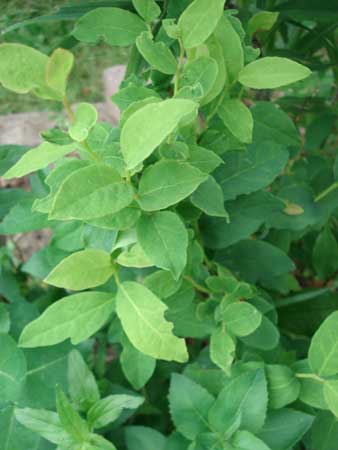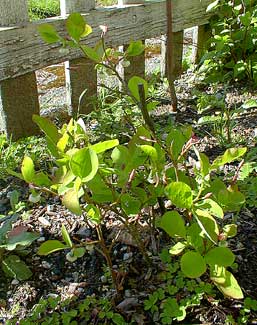
Cascade Huckleberry;
aka, Cascade Blueberry;
aka, Blue-leafed Huckleberry;
aka, Rainier Bilberry
"But hush - Earth's valleys sweet in leisure lie;
And I among them wandering up & down
Will taste their berries, like the bird or fly,
And of their gleanings make both feast & crown."
-Edmund Blunden
(1896-1974)
(1896-1974)
We obtained the miniature Cascade Huckleberry from a nearby native plants nursery. It was in a tiny four-inch pot, but after less than a year in the ground, sending its rhizomatous root system left & right even through the winter, it had spread to a ten inch round clump, & ten or so inches high, only occasionally reaching two feet high.
It should have continued to spread in an almost perfect circle until it forms a considerable groundcover, but ours never became aggressive & even after six years was a tight clump only a foot wide. If it does eventually taking up too much ground, the clump divides easily by slicing off sections around the edges to plant elsewhere. The shrub occasionally reaches two feet in height, but is more commonly only a foot.
 In autumn, the leaves turn a fiery orange-red, though not in every year, as it needs to experience a decided drop in temperature which doesn't happen every year.
In autumn, the leaves turn a fiery orange-red, though not in every year, as it needs to experience a decided drop in temperature which doesn't happen every year.Through winter it's merely upright twigs. Come April it bursts into full leaf & if it's ever going to bloom this is when it will also have tiny pink flowers, while the leaves slowly harden to blue-green. Unfortunately, at sea level it rarely blooms, & ours never has bloomed hence never fruited.
Native of Southwest British Columbia, western Washington, northwest Oregon, southeast Idaho & northern California, it prefers subalpine bogs & open forests. Berry hunters harvest the wild berries throughout the Cascades & Olympics, for considering what a short little shrub it is, it produces a great many dark blue sweet berries in its mountain environments, & even its species name alludes to its unusual flavorfulness.
Tests conducted at the University of Idaho & Washington State University have identified thirty-one aromatic flavor-chemicals in its berries! Most huckleberries, sad to say, just do not adapt to tame, commercial crops, & the Cascade huckleberry more than most just won't fruit best except in the wild, hence its pleasures are primarily for wild harvesters.
In our moderate weather we only have to take into consideration the winter winds of our hilltop location. All huckleberries are susceptible to decicating winter winds, & should have the protection of surrounding shrubbery. Subalpine Cascade Huckleberry in particular would never in its natural environment experience cold winds because its deciduous limbs would be entirely insulated by snow throughout the winter.
Ours grows in a moist perennial bed that gets considerable afternoon sun, & even the picket fence is a good windbreak for it. Cascade Huckleberry will expire quickly in drought conditions & deplores alkaline soils. They like to be fertilized regularly with acidifying fertilizer.
In nature it selects moist fertile locations near ponds, bog edges, or streams, with a preference for open locations with lots of sunlight, though they do also thrive in partial shade. In the garden it requires consistently moist humousy soil, as much as 30% or 40% organic material which is hard to maintain for the long run, & ours might bloom if we could radically upgrade the percentage of organic material in the soil, a difficult proposition without unsettling the roots of everything.
The lifecycle of huckleberries requires an unusual amount of beneficial fungus which thrives in the decaying roots of stumps & fallen trees. This is easily provided by burying wood where a shrub is first installed. But in the long-run it's very difficult to maintain & refresh such a high organic component.
To duplicate the needs of huckleberries in the garden, we've buried woodchips & peatmoss worked into the soil of a new planting is helpful, & even buried a chunk of firewood buried below the roots of young plants. When this is completely broken down & no longer producing excesses of beneficial fungus, it's all but impossible to restore the location to the huckleberry's ideal, though we've tried just pounding short limbs from pruned trees right into the ground around the dripline of such shrubs.
And yet for all the seeming difficulties of maintaining huckleberries, so long as we're not expecting gobs of harvestable fruits, most species of huckleberries adapt fine to the garden. The Cascade huck thrives even without fruiting or flowering. Its limitation, though, does make me think, from time to time, maybe I should root it out of the garden & put something flowery in that spot.